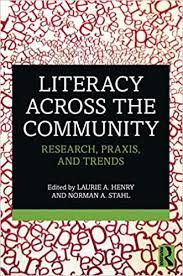Literacy Across the Community: Research, Praxis, & Trends

A Book Review with a Focus on a Chapter Highlighting the PluggedInVA Model
by Kate Daly Rolander, Ph.D.
“This is a unique volume of research and models of practice that bring together stories and learnings from programs across the lifespan and across a wide range of populations and situations.”
Literacy Across the Community: Research, Praxis, and Trends is a volume of individual research studies where each explores the many impacts of community-based literacy programs on their learners, instructors, organizations, and communities. The chapters examine how the programs bridge gaps in literacy development, promote dialogue, and connect families, communities, and schools. Showcasing the wide diversity of literacy initiatives across populations, the book brings together innovative and emerging work on the relationship between P-20 schools and community-based literacy programming. This volume identifies current trends in research and practice and addresses the challenges affecting community-based programs. Each study is a story that presents the best practices that emerge from the work of community- based literacy programs. While we often lament the lack of current research to inform our work with adult learners, this book presents itself as an invaluable resource for literacy practitioners who are curious to know more about what is happening in our field.
The book covers programs from early childhood to incarcerated youths and adults, immigrants, refugees, and indigenous communities. Chapters address topics ranging from identity and empowerment to language and literacy development across the lifespan, including rural and urban environments and partnership programs. Each offers insights through stories into how literacy is enacted in unique situations and with diverse groups of people.
Chapter Highlight
PluggedInVA: Harnessing the Transformative Power of Learner-Centered Workforce Development Programs, co-authored by Kate Rolander and Susan Watson.
Susan Watson, who formerly worked at the Virginia Adult Learning Resource Center as the ESOL Specialist and I were invited to co-author a chapter about PluggedInVA (PIVA). Laurie Henry, one of the editors of the book, was involved in the development of the PIVA model in 2008 and wanted it to be included in this volume on community literacy. We focused our chapter on the power of the PIVA model to transform learners’ identities and empower them to reimagine their opportunities.
The chapter explores the transformative impacts of PIVA, an adult education workforce development initiative in Virginia, on its learners, practitioners, and on the communities where it is implemented. The initial motivation was to build a supportive structure with a condensed timeframe that lower-skilled adults would need to strengthen their basic academic skills, earn a GED® credential, and participate in occupational training. As a model that aims to support learners’ elevation to desired workforce and training environments, a well-designed PIVA program of instruction begins to resemble those of learners’ target spaces, particularly their target work spaces.
The chapter includes reviews of previous external evaluations of the PIVA model, as well as qualitative information from interviews with two adult education program managers who have implemented a number of innovative PIVA programs. The findings from these analyses are that participation in the PIVA model enhances not only adult learners’ education and employment options, but also transforms their perceptions of themselves and the perceptions that their communities have of adult literacy activities as a vehicle to community improvement. In all the external evaluations and in both of the program manager interviews, the instructors, managers, and participating community members commented on the changes they witnessed in the adults who went through PIVA.
Learners
“It’s really what it takes—seeing themselves differently” (Program manager interview, 2019). In early studies of PIVA, learners often commented on the impacts the program had on their own outlook on life and on their potential to change: “this program helped me with my self-esteem and made me want to continue with my education” (Reflections from a 2012 – 2013 PIVA cohort). One particularly salient comment from a woman in the first PIVA cohort perfectly summarizes the identity-shifting potential of a program like PIVA. As she stood in front of an audience of legislators who had come to learn about the new innovative workforce program, she commented on her position within that space at that moment: “never in my lifetime did I think I would be speaking in front of a group of people like this, but, more importantly, that I would have anything to say that you’d be interested in hearing.” The learner-centered nature of not only the program, but also of this event, provided this woman the platform to share her narrative, her goals, and her reflections about how she perceived herself and how she perceived her place in her community. In this instance, her identity was dismantled from her self-perception of someone who had nothing worthwhile to say; in this moment, she became a public speaker, a storyteller, and a representative for an innovative project. This is the gist of what PIVA can do for its learners.
Practitioners
PIVA also impacts the practitioners who implement it. One program manager whose program has run more than sixty PIVA cohorts reflected, “it has raised my expectations of what I should do as a program manager, that just getting by is not good enough. That we have to go the extra mile with our students, and being afforded the opportunity to pro- vide training programs changes people’s lives, and, therefore, it changes my life, too.” The two program managers with whom we spoke shared that their roles had expanded to include more than the oversight of their programs; they have become partner conveners, problem solvers, workforce development experts, and community leaders.
Community
PIVA also changed how the adult education programs were perceived as members of a larger community. Before PIVA, one manager described her relationship with the local rural community college as consisting primarily of shared student referrals, but with PIVA, they became partners who planned and worked together. She commented on their participation through PIVA: “It defines who we are…it helped cement a new kind of relationship.”
The aim of PIVA is to expand access to training and career opportunities for adults who may otherwise not be admitted into or who may not succeed in traditional training programs due either to the length of time required to earn a credential or because the program represented an opportunity that the student could not see as being achievable or even appropriate for themselves. For these learners and the communities where they live, the PIVA program offers hope of something new when economies change and jobs are lost. After the pilot PIVA cohort in 2009, the program manager reflected, “Just doing that one cohort showed us how this could transform our program … could better serve our community, our students, and benefit all of us.” Both managers we interviewed shared that, through PIVA, they have witnessed transformations in their learners, in their instructors, in their programs as a whole, and in the larger communities where PIVA happens.
The chapter, along with other case studies in the book, lays out implications for more student-centered and community-driven approaches to adult literacy program design to both connect literacy practice with adults’ lives and obligations and to raise the status of adult literacy practices as an integral component of community and economic development. “We are onto something special with PIVA” (Interview, 2019). As the program continues to grow across the state and adapts to an increasing number of demands within the workforce development system, it transforms how adult education programs do business and, most importantly, how adult learners perceive their own power to change their lives.
Summary review: This is a unique volume of research and models of practice that bring together stories and learnings from programs across the lifespan and across a wide range of populations and situations. This is a must-have reference for anyone interested in advancing their understanding of and innovations in community-based literacy
*The authors would like to thank Linda Allen and Rachel Ambrose for participating in the interviews for this chapter. You have done so much to build truly transformative models of adult education. We are grateful for all the work you do for your learners and for our field.

Reference:
Henry, L., & Stahl, N. (Eds.). (2020). Community- based Literacy. Routledge.
 Dr. Kate Daly Rolander is the Workforce Education Specialist at the Virginia Adult Learning Resource Center (VALRC). She supports Virginia’s development and implementation of career pathways programs, assists instructors and staff in tailoring instruction for workforce readiness, and coordinates the state’s PluggedInVA programs.
Dr. Kate Daly Rolander is the Workforce Education Specialist at the Virginia Adult Learning Resource Center (VALRC). She supports Virginia’s development and implementation of career pathways programs, assists instructors and staff in tailoring instruction for workforce readiness, and coordinates the state’s PluggedInVA programs.